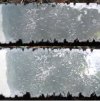- Joined
- Sep 21, 2014
- Messages
- 2,820
Good morning all. It seems as if this is canister season.
I've been reading in other posts how small amounts of what I would have called 'contaminants' don't seem to be that much of an issue, because they burn up and use any oxygen that might be left in the can. I'm trying to mimic a starry night sky in my designs and would like to try using a tiny amount of 15N20 swarf/saw dust from using a hacksaw mixed in with 1084 powder to be the diamonds in the sky. I also recently tried sprinkling some on a piece of 1080 and using my TIG torch to melt these into the bar to see if this makes any cool pattern. One thing I noticed while doing this was some of the swarf burned off instead of melting, and I think this was some of the paint/powder-coating from the hacksaw blade in the sawdust.
My question is: will this paint contamination lead to bad inclusions/welds/pockets in the finished billet or will this just burn off like paper does?
Thanks
I've been reading in other posts how small amounts of what I would have called 'contaminants' don't seem to be that much of an issue, because they burn up and use any oxygen that might be left in the can. I'm trying to mimic a starry night sky in my designs and would like to try using a tiny amount of 15N20 swarf/saw dust from using a hacksaw mixed in with 1084 powder to be the diamonds in the sky. I also recently tried sprinkling some on a piece of 1080 and using my TIG torch to melt these into the bar to see if this makes any cool pattern. One thing I noticed while doing this was some of the swarf burned off instead of melting, and I think this was some of the paint/powder-coating from the hacksaw blade in the sawdust.
My question is: will this paint contamination lead to bad inclusions/welds/pockets in the finished billet or will this just burn off like paper does?
Thanks

